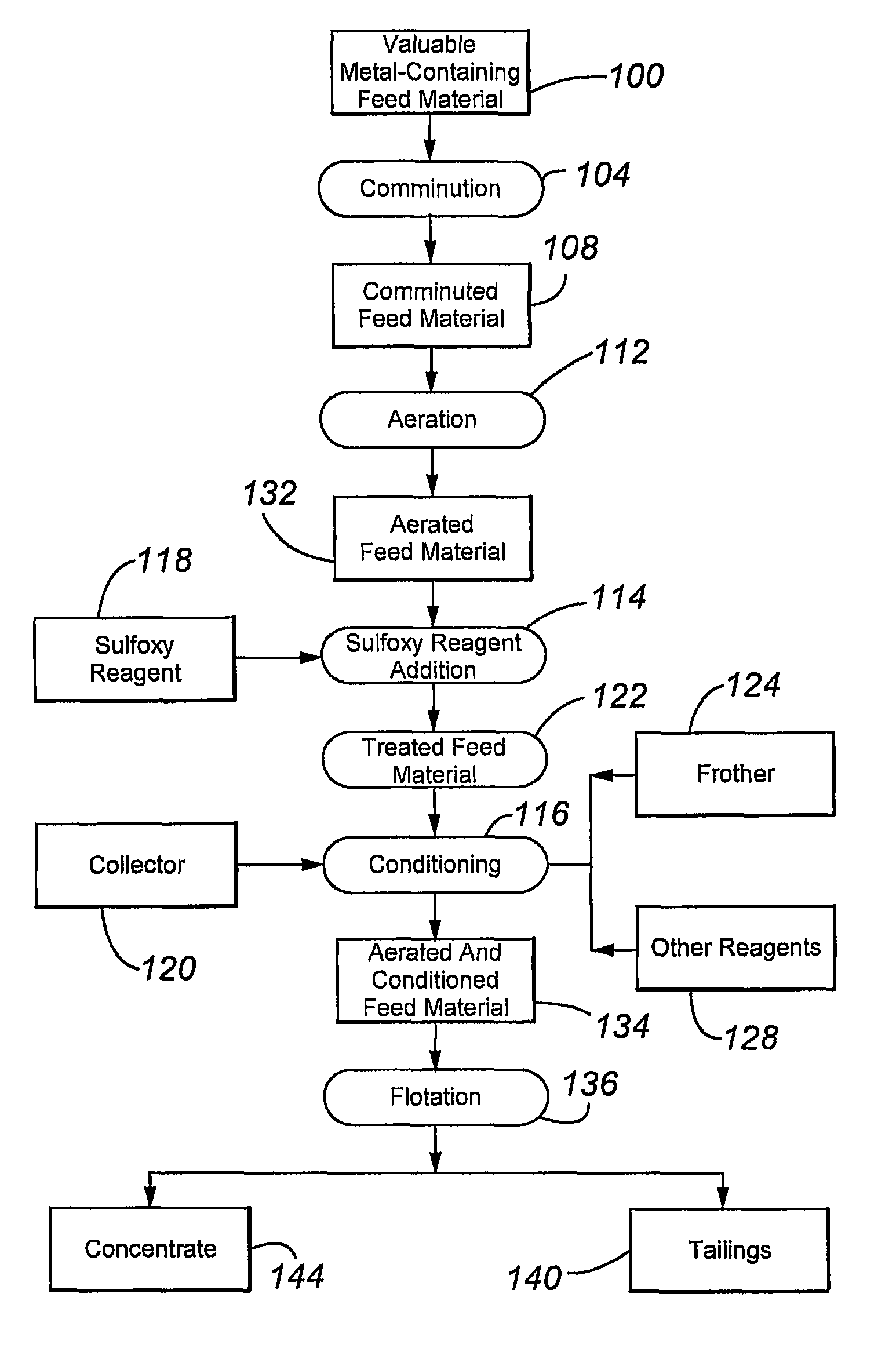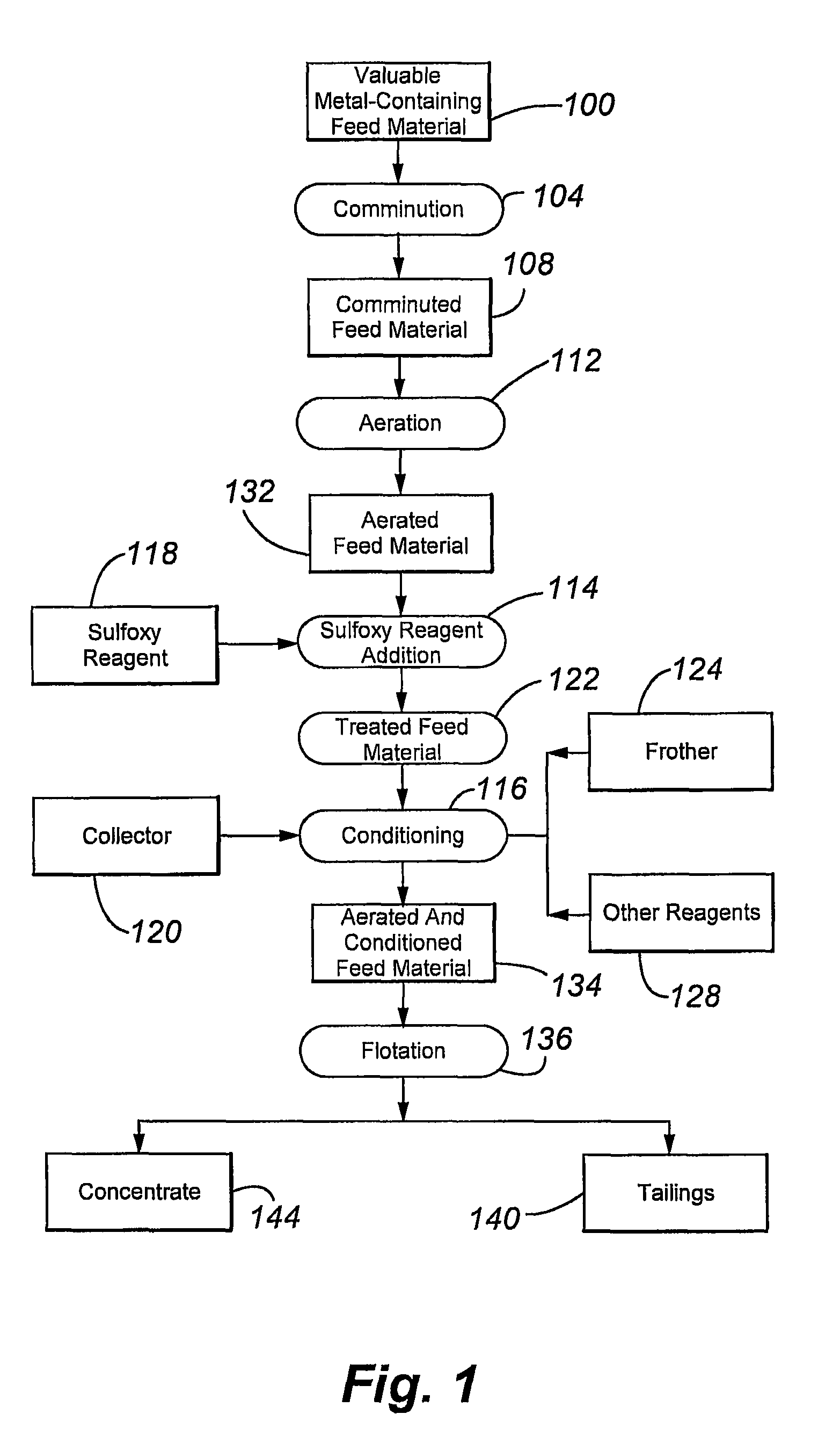Separation of copper minerals from pyrite using air-metabisulfite treatment
a technology of pyrite and air-metabisulfite, which is applied in the field of metal recovery, can solve the problems of large quantities of lime and other reagents, high ph values, and inability to use over a wide ph range, and achieves improved copper sulfide mineral concentrate grade, improved copper sulfide mineral flotation rate and recovery, and increased sulfoxy reagent consumption
- Summary
- Abstract
- Description
- Claims
- Application Information
AI Technical Summary
Benefits of technology
Problems solved by technology
Method used
Image
Examples
example 1
Conventional Flotation Methods
[0092]This example demonstrates the effect that the composition of water employed in the flotation pulp has on the recovery of copper, when various reagents are used to depress pyrite and concentrate copper. As shown in Table 1, the salt water employed has considerably higher total dissolved solids content and conductivity than the tap water.
[0093]
TABLE 1Composition of Tap and Highly Buffered Site WaterParameterUnitsTap WaterSalt WaterpHpH7.818.48ConductivityμS / cm0.965360TDSmg / L40540225Sodiummg / L19112060Potassiummg / L9.3414Calciummg / L332426Magnesiummg / L10.41297Ironmg / L0.17Chloridemg / L19920738Bicarbonatemg / L12070Sulfatemg / LNIL2890
[0094]FIG. 3 is a simplified flow diagram of the kinetics tests conducted in this example. The flow diagram includes comminuted feed material conditioning 300 to form a conditioned feed material 304, rougher flotation 308 of the conditioned feed material 304 (using five flotation machines) to form rougher tailings 312 and rougher...
example 2
Aeration / Sulfoxy Reagent Methods
[0101]Additional tests were conducted using a similar flotation circuit as employed in example 1 with the exception of the addition of 300 g / t before the first stage of cleaner flotation and an additional 300 g / t metabisulfite (MBS) (the sulfoxy reagent) during the secondary grind. In other words and as shown in Table 4 below, a total of 600 g / t MBS has been added in the flotation circuit.
[0102]The flotation circuit is shown in the flow chart of FIG. 4. The flow chart includes conditioning 400 of the comminuted feed material 108 to form conditioned feed material 404, rougher flotation 408 (using five flotation machines or stages) to form rougher concentrate and tailings fractions 412 and 416, respectively, secondary comminution 420 of the rougher concentrate 412, in the presence of sulfoxy reagent 118, to form a recomminuted rougher concentrate 412, aeration 112 of the recomminuted rougher concentrate 412 (for 0 (which means no aeration was performed)...
example 3
Aeration / Sulfoxy Reagent Methods
[0106]Additional tests were conducted using the same flotation circuit of FIG. 4 as employed in example 2, with the exception that brackish site water was employed. Analysis of the site water is shown in Table 5. The tests were carried out, with and without, a 30-minute aeration step after the secondary grind and prior to the cleaning flotation circuit. The effect of the aeration, after MBS addition, on sulfide depression and copper grade / recovery was investigated. For reference the grade recovery curve with tap water is shown in FIG. 10.
[0107]
TABLE 5Composition of Tap and Highly Buffered Site WaterParameterUnitsSite WaterpHpH7.02ConductivityμS / cm10.38TDSmg / L7515Sodiummg / L1940Potassiummg / L11.2Calciummg / L620Magnesiummg / L84.5Ironmg / LChloridemg / L2535Bicarbonatemg / L30Sulfatemg / L1198
PUM
| Property | Measurement | Unit |
|---|---|---|
| salinity | aaaaa | aaaaa |
| pH | aaaaa | aaaaa |
| pulp density | aaaaa | aaaaa |
Abstract
Description
Claims
Application Information
 Login to View More
Login to View More - R&D
- Intellectual Property
- Life Sciences
- Materials
- Tech Scout
- Unparalleled Data Quality
- Higher Quality Content
- 60% Fewer Hallucinations
Browse by: Latest US Patents, China's latest patents, Technical Efficacy Thesaurus, Application Domain, Technology Topic, Popular Technical Reports.
© 2025 PatSnap. All rights reserved.Legal|Privacy policy|Modern Slavery Act Transparency Statement|Sitemap|About US| Contact US: help@patsnap.com



